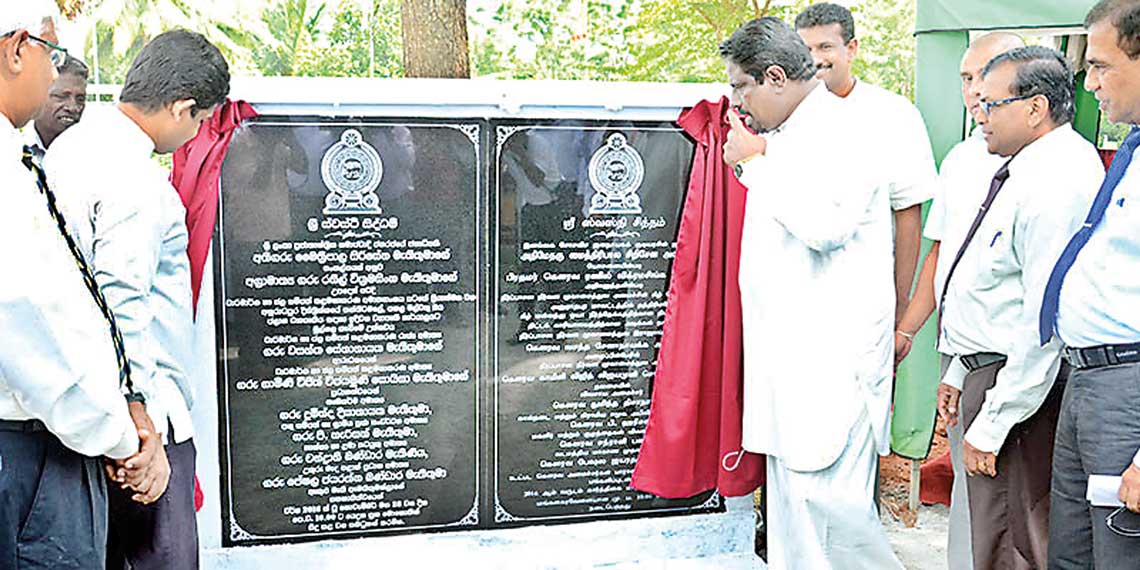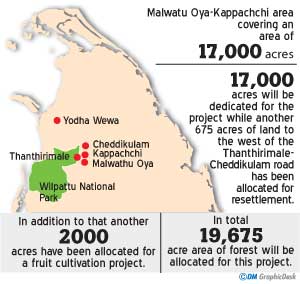31 Jan 2018 - {{hitsCtrl.values.hits}}

 The Wilpattu forest reserve made headlines with massive deforestation practices taking place over the past few years. Although these activities seem to be in a dormant stage as at now, the necessary damage has already been done. Last December, the Auditor General issued a comprehensive report on the illegally deforested Wilpattu Forest Reserve. Following this report, the Dailymirror initially reported on the current status of this proposed resettlement project and the threats identified by environmental groups. However it seems that various other projects, including the Lower Malwatu Oya Project – a project paused for 30 years due to the ethnic conflict, have commenced operations once again.
The Wilpattu forest reserve made headlines with massive deforestation practices taking place over the past few years. Although these activities seem to be in a dormant stage as at now, the necessary damage has already been done. Last December, the Auditor General issued a comprehensive report on the illegally deforested Wilpattu Forest Reserve. Following this report, the Dailymirror initially reported on the current status of this proposed resettlement project and the threats identified by environmental groups. However it seems that various other projects, including the Lower Malwatu Oya Project – a project paused for 30 years due to the ethnic conflict, have commenced operations once again.
Hence, the Dailymirror sheds light on the impact of this project which required clearing more than 19,000 acres of forest land, destroying more resources and imposing threats on endemic species in this forest reserve.

Speaking to the Dailymirror, Kanthi De Silva, Deputy Director General – Environmental Management and Assessment Division (EMA) of the CEA said that an EIA is conducted only with regard to legal projects. “But for this, the consent of the land owner is a prerequisite. Prior to starting an EIA the land clearing needs to be done. With regard to this particular issue in Wilpattu, where 700 acres were cleared for resettlement, the CEA was not aware of it to begin with. The Forest Department should have cleared this land prior to conducting an EIA.
If the project isn’t approved by the Government the CEA should be informed
The process includes six steps from screening to scoping, preparation of the EIA report, review of the report by the public and the Project Approving Agency (PAA), approval with terms and conditions or rejection with reasons and post approval monitoring. If the project is not approved by the Government the CEA should be informed at the beginning,”said De Silva.
The above project falls under the purview of the Ministry of Irrigation and Water Resources Management as a priority project. Speaking to the Dailymirror, Engineer Sisira Kumara, Secretary of the subject ministry, said that the Engineering, Procurement and Construction (EPC) contract is currently being evaluated. “The EIA too is being conducted via a company we selected to handle the necessary work. The Environmental authority requested us to submit an EIA which we will draft and send out for public opinion. The project will feed tributaries and the Yoda Wewa in Mannar. The project is currently at a negotiation stage and if we get the EIA approved, the project will proceed,” said Kumara.
The EIA too is being conducted via a company we selected to handle the necessary work

Speaking at a press conference organised to expose findings about this Project, Ven. Waakadawala Rahula Thera said that with the implementation of the Mahaveli Development Project huge damage was caused to the environment. “We know that there is a struggle to protect the rest of the natural resources left for us. The deforestation that took place during every regime has become a major social issue today.
The destruction of the Wilpattu-Kallaru Forest Reserve is part of a bigger development plan, known as the National Physical Plan 2011-2030
The destruction of the Wilpattu-Kallaru Forest Reserve is part of a bigger development plan, officially known as the National Physical Plan 2011-2030. There are various isolated protests to justify the alleged involvement of Minister Rishad Bathiudeen, but it is not only he who is to blame. The President, Environment Minister and every other regime that existed have actively contributed to these deforestation practices. The Lower Malwatu Oya Project is another one of those plans. For this purpose over 19,675 acres of land will be cleared as an initial step to carry out this project. As a result of these projects natural habitats are rapidly destroyed and it has imposed a threat on endemic species of flora and fauna,”the Thera said.

Environmentalist and Centre for Environmental Studies (CENS) Executive Director Ravindra Kariyawasam said that in 2009 a road had been constructed via the Wilpattu Forest Reserve and it’s Northern Border, separating the habitat in two. “From 2009 till 2016 this destruction had continued in  various other places of the forest reserve as well. Therefore the Wilpattu National Park, Kallaru and Marichikaddu are directly affected by this destruction and adding to this is the Lower Malwatu Oya Project as mentioned by Ven. Rahula Thera. This project will be continued across the Malwatu Oya-Kappachchi area covering an area of 17,000 acres. As a result of this project the water capacity is expected to increase by 290 cubic metres and the water is to be distributed to the surrounding areas.
various other places of the forest reserve as well. Therefore the Wilpattu National Park, Kallaru and Marichikaddu are directly affected by this destruction and adding to this is the Lower Malwatu Oya Project as mentioned by Ven. Rahula Thera. This project will be continued across the Malwatu Oya-Kappachchi area covering an area of 17,000 acres. As a result of this project the water capacity is expected to increase by 290 cubic metres and the water is to be distributed to the surrounding areas.
The Lower Malwatu Oya Project is a result of an agreement inked by the Sri Lankan and the Russian Governments back in 1960. But due to the 30-year-conflict this project was halted. Work in this project was commenced last year, but even then there was no Environmental Impact Assessment (EIA) done. But the National Environmental Act No. 47 of 1980 specifies that if an area of more than two and a half acres is being cleared for any project, an EIA has to be done. If you take this project, 17,000 acres will dedicated to the project while another 675 acres of land to the west of the Thanthirimale-Cheddikulam Road have been allocated for resettlement. In addition to that another 2000 acres have been allocated for a fruit cultivation project. So in total, a 19,675 acre forest area will be allocated for this project. This extent of land also includes areas such as Sarattikulam, Bandiwewa and Sinnakkulam. When such a massive project has already been implemented, the Environmental Ministry and the Central Environmental Authority (CEA) have not shown any interest to carry out an EIA,”said Kariyawasam.
When this excess water is reserved the Wilpattu National Park will not get adequate water
Speaking further Kariyawasam said that the assessment then needs to be presented to the public for reference. “Therefore this is another illegal project. The dam will be constructed by a Chinese company and the income generated will be given back to the employees of this company who will be involved in constructing the project. Another important fact to note is that this project will only distribute water to another 2000 acres of land. But this area includes Yoda Wewa which supplies water to many paddy fields and other cultivations in the area. So to give water to an extra 2000 acres, a 19,000 acre area of forest land will be destroyed. As a result of this project many species of flora and fauna are facing threats.
The Lower Malwatu Oya Project is a result of an agreement inked by the Sri Lankan and the Russian Governments back in 1960.
Environmental studies conducted in this area have identified 41 species of mammals, 29 species of fish, 17 species of amphibians and 149 species of birds. These areas are also inhabited by elephants and they too could face a massive threat. The irrigation system which flows on either side of the Malwatu Oya and Kappachchi area will also be destroyed. The proposed project is said to lower the chances of floods occurring in the Vavuniya District, but it is clear that the ‘villus’ in Wilpattu are fed by the excess water flowing from Malwatu Oya. When this excess water is reserved the Wilpattu National Park will not get adequate water. Therefore many paddy fields and other cultivations will be greatly affected. In other words it is quite impractical to implement a project which was proposed back in the 1960s and the necessary authorities need to open their eyes and look closely at the destruction caused by these projects,” he added.
Airing his views on the issue of deforestation, Dr.Prasanna Cooray said that it could lead to long periods of drought. “One of the main contributors to global warming is deforestation and one of the countries that carry out deforestation is Sri Lanka. According to a research done by the University of Gothernberg, Sweden, Sri Lanka stands in fourth place in the list of countries that carry out deforestation at large. As a result of deforestation, the forest cover in the country lies as low as 16%, but the Government continues to show exaggerated figures. Development practices in the North and East should take place with the knowledge of those settled there. There are various issues with regard to resettlement approaches and uplifting their livelihoods. Without attempting to find any solution to these issues, it is very wrong that the Government continues to implement such unplanned projects which would cause more harm to the people,”said Dr. Cooray.
Development practices in the North and East should take place with the knowledge of those settled there
One main concern in this clearing of forest land is that no Environmental Impact Assessment (EIA) was done given that it is a priority. Without conducting an EIA the authorities involved took their first illegal step in proceeding with the deforestation of Wilpattu Forest Reserve.
As more skyscrapers and concrete establishments are substituting the greenery it has imposed threats on both humans and animals
A country that once had a massive forest cover at present suffers with just 16% of greenery across the country. Cohabiting with other species is a necessity as trees and animals are active participants in the ecosystem. As more skyscrapers and concrete establishments are substituting the greenery across the country it has imposed threats on both humans and animals. The International Association of Impact Assessment (IAIA) defines an EIA as the process of identifying, predicting, evaluating and mitigating the biophysical, social and other relevant effects of development proposals prior to major decisions being taken and commitments made. In Sri Lanka, the National Environmental Act, 1998 requires EIAs for large scale projects in sensitive areas and is enforced by the Central Environmental Authority (CEA).
24 Nov 2024 7 hours ago
24 Nov 2024 24 Nov 2024
24 Nov 2024 24 Nov 2024
24 Nov 2024 24 Nov 2024